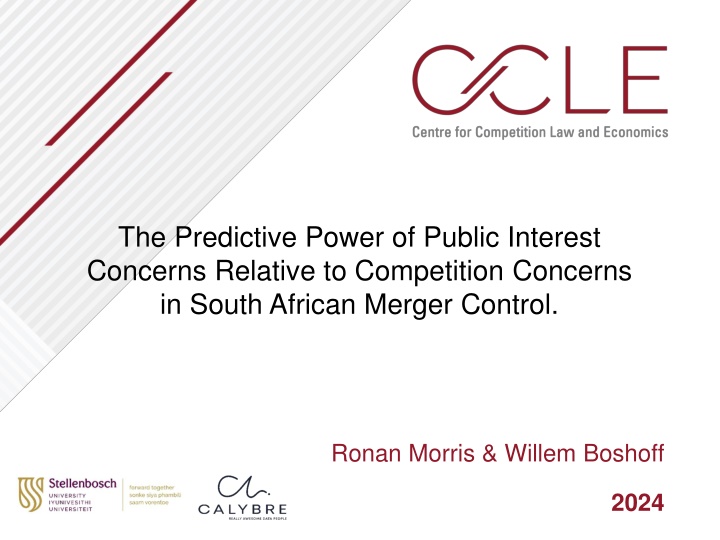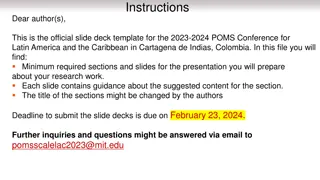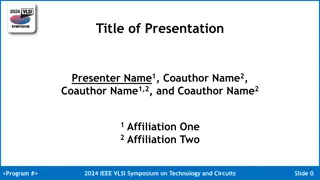
Public Interest vs. Competition Concerns in South African Merger Control 2024
Explore the dynamic interplay between public interest and competition concerns in South African merger control, investigating whether the Competition Commission prioritizes one over the other. Delve into the main hypothesis indicating that public interest concerns drive the merger control process more than individual competition concerns, with secondary hypotheses highlighting disparities in treating public interest concerns and the interventionist nature post-2018 amendments to the Act.
Download Presentation

Please find below an Image/Link to download the presentation.
The content on the website is provided AS IS for your information and personal use only. It may not be sold, licensed, or shared on other websites without obtaining consent from the author. If you encounter any issues during the download, it is possible that the publisher has removed the file from their server.
You are allowed to download the files provided on this website for personal or commercial use, subject to the condition that they are used lawfully. All files are the property of their respective owners.
The content on the website is provided AS IS for your information and personal use only. It may not be sold, licensed, or shared on other websites without obtaining consent from the author.
E N D
Presentation Transcript
The Predictive Power of Public Interest Concerns Relative to Competition Concerns in South African Merger Control. Ronan Morris & Willem Boshoff 2024
Background In South Africa, mergers can experience intervention from the competition authorities. Reasons for intervention from the competition authorities: Competition Public Interest Competition reasons would include unilateral Public interest concerns include the protection effects, bundling, collusion, etc... of national industries, employment, the ability of small firms to compete, and broad-based black economic empowerment (BBBEE). OUR QUESTION: Does the Competition Commission give preference to either competition concerns or public interest concerns during merger control? 2
Background Neither concern, competition or public interest, is considered more important in the legislation. 2018 2023 The main objectives of the Amendment Act were to 2023 Amended Guidelines state that public deal with the structural interest concerns and competition concerns are challenges of high levels of concentration and racially equal in status (DTIC, 2023:29). skewed ownership of firms in the South African economy. The case for the intervention of a merger can be made through competition or public interest concerns, independently. 3
Hypotheses MAIN HYPOTHESIS Public interest concerns are stronger drivers of the merger control process than individual competition concerns. COMPETITIONCONCERNS PUBLIC INTEREST CONCERNS 4
Hypotheses MAIN HYPOTHESIS Public interest concerns are stronger drivers of the merger control process than individual competition concerns. COMPETITIONCONCERNS PUBLIC INTEREST CONCERNS Interventions Non-Interventions 5
Hypotheses SECONDARY HYPOTHESIS 1 Not all public interest concerns are treated equally by the Commission during merger adjudication. PROPORTION OF CASES FEATURING PUBLIC INTEREST CONCERNS 6
Hypotheses SECONDARY HYPOTHESIS 2 After the 2018 amendments to the Act, the Commission became increasingly interventionist, ceteris paribus. INTERVENTIONS 7
Methodology RANDOM FOREST ALGORITHM 8
Methodology More Simply, thousands of these: 9
Methodology MACHINE LEARNING vs ECONOMETRICS WHY RANDOM FOREST? Variable Importance rankings. Supervised (i.e. not a "black Higher out-of-sample prediction box"). accuracy. Continuous bootstrapping and Incredibly robust. aggregation of predictions. But, less intuitive... Robust to small sample sizes. 10
Methodology VARIABLE IMPORTANCE PLOTS PARTIAL PROBABILITY ANALYSIS Widely used in the computer science Represents the change in the expected literature (Gr mping, 2009:308). response of the model as you vary the specific variable of interest, ceteris Gini-importance: paribus (Boeleart & Ollion, 2018:495). Similar idea, but NOT the same as "marginal effect" in econometrics. 11
Results The model predicts interventions with an accuracy of 86.6%. TRUE POSITIVE RATE (TPR) 80.1% TRUE NEGATIVE RATE (TNR) 92.7% 12
Results VARIABLE IMPORTANCE PLOT All public interest variables rank higher than individual competition concerns. The 2018 Amendments were the second most important variable. There is heterogeneity in the importance of public interest concerns. 13
Results PARTIAL PROBABILITYANALYSIS After 2018, the average probability of intervention increased by 24.8%, ceteris paribus. A small business concern raises the probability of intervention by 67.2%. 14
Results FOR COMPARISON Raising one small business, BBBEE, or national industries concern, increases the probability of intervention by more than raising three separate competition concerns. PARTIAL PROBABILITY FOR COMPETITION CONCERNS 15






















